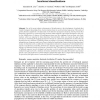1746 search results - page 35 / 350 » On Compressibility of Protein Sequences |
CIBCB
2009
IEEE
13 years 8 months ago
2009
IEEE
Tools for the identification of trans-membrane spans from the protein sequence are widely used in the experimental community. Computational structural biology seeks to increase the...
IJDMB
2010
13 years 6 months ago
2010
: We explore whether protein-RNA interfaces differ from non-interfaces in terms of their structural features and whether structural features vary according to the type of the bound...
NAR
2010
13 years 2 months ago
2010
The prediction of protein function as well as the reconstruction of evolutionary genesis employing sequence comparison at large is still the most powerful tool in sequence analysi...
BMCBI
2005
13 years 7 months ago
2005
: One of the most evident achievements of bioinformatics is the development of methods that transfer biological knowledge from characterised proteins to uncharacterised sequences. ...
ICIP
1994
IEEE
14 years 9 months ago
1994
IEEE
Stereoscopic sequence compression typically involves the exploitation of the spatial redundancy between the left and right streams to achieve higher compressions than are possible...

